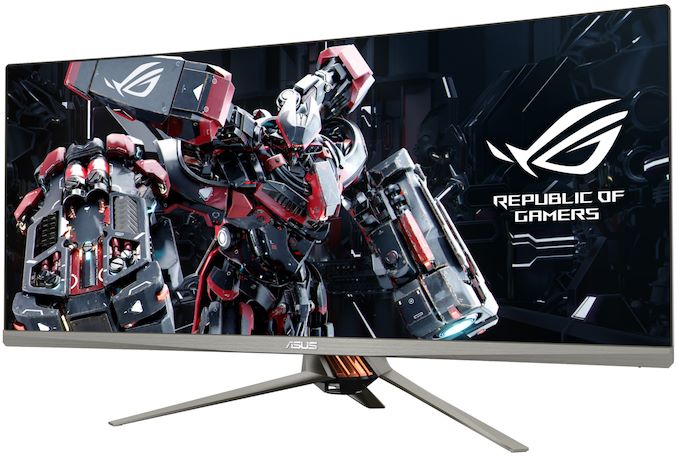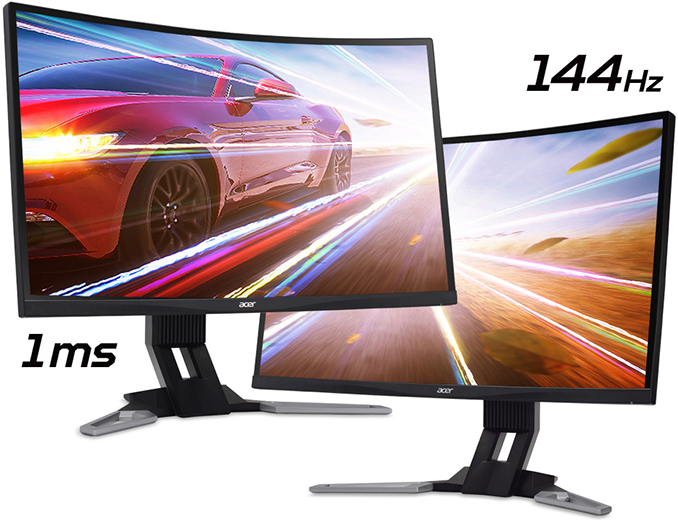Sales of High Refresh Gaming Displays Skyrocketing, Curved Gaming LCDs Prevail
by Anton Shilov on December 7, 2018 2:00 PM EST- Posted in
- Displays
- Acer
- Samsung
- Asus
- BenQ
- AOC
- Monitors
- Market Trends
- Philips
- Curved Display

The number of news stories about gaming displays that we post has increased significantly in the past couple of years. Established suppliers have broadened their lineups of gaming LCDs, and meanwhile new players have decided to join the party. Apparently, our coverage has been reflecting market sales trends, as sales of such monitors have been increasing at a rapid pace. According to WitsView, shipments of displays with a 100 Hz refresh rate or higher (i.e., gaming LCDs) will exceed five million units in 2018. Moreover, over half of them will be curved monitors.
Curved Gaming LCDs Leave Flat Displays Behind
Global sales of gaming displays with high refresh rates are expected to reach 5.1 million units in 2018, an annual growth of 100%, reports WitsView, a division of TrendForce. This is still a small fraction of the 126 million total LCDs projected to be sold in 2018 (up 1.5% year-over-year), according to the company. The researchers attribute the growing demand for displays with high refresh rates to recommendations from game developers, with groups such as the PlayerUnknown's Battlegrounds devs recommended 144 Hz+ displays. Meanwhile, it is evident that as the number of available models on the market is increasing, their prices are getting lower and gamers are more inclined to buy them.
One interesting point about gaming displays in general is that 54% of gaming LCDs sold this year will be curved monitors, leaving only 46% of them to be flat. Last year 77% of gaming displays were flat and only 23% were curved, according to WitsView. Shipments of around 2.75 million units is a big win for curved LCDs at large. In fact, keeping in mind that there are even more numerous curved models with refresh rates below 100 Hz, it is safe to say that sales of such displays in general will clearly surpass 5 million units, up from around a million in 2015. Since price difference between curved and flat monitors is diminishing, curved displays are no longer penalized with a price premium.
ASUS Leading the Pack
When it comes to suppliers of gaming displays, ASUS has been leading the pack for quite a while now, and this year was no exception. Acer maintained its second spot in 2018. By contrast, BenQ left the Top 4 and the third place now belongs to TPV, which sells products under AOC and Philips brands and is particularly successful in the Chinese, European, and APAC markets. Samsung moved up to fourth place (from the No. 5 spot) after expanding its gaming lineup with numerous new models in 2017 – 2018 timeframe, including the world’s first FreeSync 2-supporting monitors and numerous curved models of various sizes. It is noteworthy that 95% of Samsung’s gaming displays are curved.
| Top Suppliers of Gaming LCDs in 2017 - 2018 Data by WitsView, December 2018 |
|||
| Ranking | 2017 | 2018 Estimation |
|
| 1 | ASUS | ASUS | |
| 2 | Acer | Acer | |
| 3 | BenQ | AOC/Philips | |
| 4 | AOC/Philips | Samsung | |
| Shipments | 2.5 million | 5.1 million | |
Other vendors with impressive sales growth in 2018 noted by WitsView are MSI, HKC, and SDC. The latter two are particularly successful in China, whereas MSI is promoting its Optix gaming displays globally. Meanwhile, general LCD market leaders like Dell, HP, Lenovo, and LG are not exactly among the frontrunners on the market of gaming monitors.
| Top LCD Suppliers: 2017 - 2018 Data by WitsView, October 2018 |
|||||||
| 2017 | 2018 (Estimated) |
||||||
| Ranking | Brand | Market Share | Ranking | Brand | Market Share | ||
| 1 | Dell | 18.5% | 1 | Dell | 19.6% | ||
| 2 | AOC/Philips | 13.5% | 2 | HP | 13.8% | ||
| 3 | HP | 12.7% | 3 | AOC/Philips | 13.1% | ||
| 4 | Lenovo | 9.8% | 4 | Lenovo | 9.6% | ||
| 5 | Samsung | 9.6% | 5 | LG | 8.7% | ||
| 6 | LG | 9.3% | 6 | Samsung | 7.6% | ||
| 7 | Acer | 6.0% | 7 | Acer | 6.8% | ||
| Others | - | 20.5% | Others | - | 20.8% | ||
| Shipments | - | 123.7 million | Shipments | - | 125.6 million | ||
Related Reading:
- Acer Unveils KG1 Displays with Sub-1ms Response Time
- ASUS Lists ROG Strix XG32VQR Curved FreeSync 2 Display with RGB
- JapanNext Launches 35-Inch "UWHD" Curved LCD: AMVA & 200Hz Refresh w/FreeSync
- MSI’s 49” Optix Curved Display and Oculux 25” High Refresh Monitors Announced
- ASUS Announces ROG Strix XG32VQ and ROG Strix XG35VQ: Large, Curved, & Fast
- Smooth As 240 Hz Butter: LG's 27GK750F-B, a 27-inch eSports Monitor with FreeSync, Launched for $550
- BenQ Announces ZOWIE XL2546 ‘eSports’ Display: 24'', FHD, 240 Hz, DyAc ULMB Tech
Source: WitsView/TrendForce











75 Comments
View All Comments
SquarePeg - Friday, December 7, 2018 - link
The price of 4k monitors is ridiculous. I already know that my next "monitor" will be a 4k HDR 4:4:4 television with Freesync.FreckledTrout - Friday, December 7, 2018 - link
We are supposed to have Mini-LED panels in 2019 from AUO(Not to be confused with Micro-LED). Should have over 1,000 dedicated backlight zones in 27 and 32 inch monitors.Lolimaster - Saturday, December 8, 2018 - link
For monitors with mini LED the minimum should be 2000 and 5000-10000 for the high end.For TV's from 5000 all the way to 50000
Samus - Friday, December 7, 2018 - link
My Philips 144Hz LCD (a TN panel obviously) is probably the lowest quality LCD I've seen since dual scan LCD's from early 90's laptops. It's useless for anything but gaming, which is its purpose, but I still regret not just getting a 100hz IPS\PVA panel. Sadly, 144Hz applications span more than just gaming. Once you use this thing you appreciate it's response time in even basic windows tasks. The mouse cursor moves butter smooth and scrolling is superbly natural.That said, I plan on holding on to it until high quality 144Hz panels become a thing.
AnnoyedGrunt - Saturday, December 8, 2018 - link
I just bought one of the Acer Predator G-sync IPS displays. It is 144 Hz, overdrivable to 165, 27", 1440P, and a flat screen. I think it is awesome. Very happy with how it looks and running @ the high refresh is very nice on the eyes. No idea how accurate the colors are, but it looks very good.I think a big reason curved displays are selling so much is because it is difficult to find a non-curved display in the larger sizes. ASUS has basically the same monitor, but it is ~$50 more expensive.
I'd consider both the Acer and the ASUS as high quality in everything except perhaps color accuracy (just don't have data for that).
-AG
nunya112 - Friday, December 7, 2018 - link
its because finally they have VA panels that go above 60hz. that has been the limiting factor. most ppl who know. Will tell TN panels to suck DEEZ... and then up till this year VA panels have only gone to 60hz. This has now changed. and its a win for everyone.Spunjji - Sunday, December 9, 2018 - link
That's not correct. The Eizo Foris was the first VA display commercially available with a 120hz refresh rate, and that was back in 2013 (I have one on my desk). The tech isn't new, but reaching these lower price points is definitely new.Mr.Vegas - Friday, December 7, 2018 - link
All I want is Gsync + HDR1000 + not Kiddie size of 35inch MINIMUMWhere are all GsyncHDR monitors? The only ones out are 27inch Asus/Acer 4K models, 27inch? in 2018??? SERIOUSLY!
Right now im using 55inc 4K OLED with HDR and its GREAT, but i want Gsync and lower refresh rate, 4K is great but one step below 4K will give my 2080Ti more headroom running Ray traced games.
Asus and Acer announced VA+HDR100+Gsync + 200Hz monitors early 2017, Predator x35 and ROG SWIFT PG35VQ, what happened to them?
WHERE ARE MY MONITORS?!
Mr.Vegas - Friday, December 7, 2018 - link
No edit button?I meant to say Lower resolution, not lower refresh rate
Lolimaster - Saturday, December 8, 2018 - link
Your 2080ti is already obsolete for ray trace, it barely handles BFV, and it's the 1st attempt on a 1st gen product.I would not care much about RTX till the dedicated computing for that task gets 10-20x uplift. You basically payed for RTX, a 1st gen that will be on the dust pretty fast, 2070 was the smart choice.